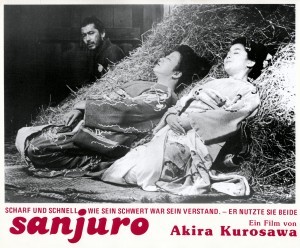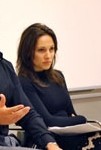Michael Rogan's Blog, page 3
February 16, 2016
5 Screenwriting Hacks Every Writer Can Steal (Borrow) From “The Wolf Man”
“The Wolf Man” from 1941 represents not only Universal Studios at the height of its classic horror period, but its a film that literally “wrote the book” on werewolf lore. (There ain’t no “silver bullets” and “full moon” wolf-y stuff without this movie.)
And though “The Wolf Man” may seem a bit implausible during a modern viewing – do any of us really believe that 5’6 English Claude Rains is the father of 6’3 American Lon Chaney Jr. – the film does offer a case study in how screenwriter Curt Siodmak not only built a vibrant story world…
…but also helped exorcise some of his personal demons. (In the service of a ripping classic horror yarn.)
So, sit back, relax (but dont’ get too relaxed) and enjoy these 5 things every screenwriter can learn from the classic movie “The Wolf Man.”
Screenwriting Hack #1 You Can Steal From “The Wolf Man”: All Good Horror Movies Start With “Personal” Horror
“The Wolf Man” these days may seem like a run-of-the-mill horror flick, in which the main character gets to embrace his inner cocker spaniel, but the inspiration for screenwriter Curt Siodmak was far more personal.
The holocaust.
Siodmak had fled the persecution of the Jews in Dresden, Germany and found himself drawn to writing a Greek tragedy, “disguised” as a horror film.
A story in which the gods have cursed the “hero” of a story. And this “hero” may appear to be a monster, but he is simply the victim of a curse. An outsider on the fringes of society who is hated, pursued, hunted – and eventually killed – by a mob who don’t learn until too late that he is one of them.
And the one plot device that Siodmak fought for the hardest was the “mark of the pentagram” that each victim of the wolf carries with them to designate their dim prospects for the future. It was this plot detail that Siodmak felt most resonated with his own experience as a Jew, labeled in war-time . (And transformed his “little horror picture” into something far more powerful and lasting.)
Action Step: If yer writing a horror picture, start off with your own personal horror. (And then find a dramatic, visual way to express that horror.)
Screenwriting Hack #2 You Can Steal From “The Wolf Man”: When in Doubt, Create Your OWN History
Much of the exposition in the “Wolf Man” goes to great lengths to establish that lycanthropy – the affliction of being a big, bad wolf-y – has its origins in the ancient world.
With legend having it that the victim, after being bitten, becomes full-on werewolf during a full moon. And that the only way to kill a werewolf is with silver.
And it sounds very plausible. (An old-time, Gypsy legend-y.)
Only it’s total bullshit.
Siodmak made it all up. The only “legend” of lycanthropy had to do with a person unwittingly eating a wolf’s brain. (Fat chance, that.)
Siodmak is the one who made the brilliant creative decision to make “werewolf transmission” much more intimate, through a bite. And by tying the wolf’s ascendance to the moon he came up with a kick-ass to build a time lock – that boosts tension without revealing the transformation too early.
Action Step: Feel your story lacks urgency or stakes? Simply give it a historical basis – that you, of course, make up – and use your newfound legend and lore to boost your story’s potential.
Screenwriting Hack #3 You Can Steal From “The Wolf Man”: Your Story Solutions Can Come From Anywhere
Though the initial spark for the story came from Siodmak’s traumatic experience as a Jew in Third Reich Germany , many of the film’s other crucial elements came from a more mundane, everyday genesis.
Take the role of silver in the movie.
Siodmak needed an “Achilles Heel” for his wolf man. Something, that though uncommon, would prove to be his undoing.
And so, one day Siodmak was listening to “The Lone Ranger” on radio. And when he heard that good, old “Hi-Ho, Silver!” – Siodmak knew he had the ultimate werewolf equalizer. Silver. (Little did he know that he would be creating pillars of werewolf mythology for more than a half-century.)
Action Step: While you’re in the midst of writing your script – and banging your head against the wall trying to find a story solution – be open to finding that storytelling resolution in the most unlikely of places.
Screenwriting Hack #4 You Can Steal From “The Wolf Man”: Make Your Climax as Emotional (and Intimate) as Possible
Spoiler alert: I’m about to reveal the ending to a movie that was released in 1954. (Letting all you “Twitter trolls” get ready.)
In case it’s been awhile since you’ve seen “The Wolf Man,” the film ends with a climactic showdown in which wolf-infused Lon Chaney Jr. attacks the woman his “human self” is in love with. (Played by…)
She is saved by the wolf-dude’s father, played with grace and charm by Claude Rains, who happens upon his “wolf son” and beats him with his “silver cane” – but not before Chaney Jr. takes out Dad…
…and the villagers arrive (a little late to the party) to find Chaney Jr. turning back into a human, right before he dies.
Talk about an uplifting ending! (I’m sure if Michael Bay had directed it there would have been a female lycanthropy scientist there wearing a mini-skirt.)
Still, what’s most interesting about that ending is what Siodmak originally wrote. (Namely having the Mr. Wolf Man killing a random villager and then having his father shoot him with a revolver that contained a silver bullet.)
But Siodmak made TWO KEY CHANGES:
1) He had the SON kill the FATHER (Nice bit of Freudian stuff there)
2) He had the WOLF killed much more INTIMATELY (Up close with a cane, not from a distance with a pistol)
Siodmak felt the ending needed to be more visceral. More immdiate. More grueling for the characters. (And the audience.)
And what could be more grueling than having a father have to kill his son in hand-to-hand combat. (And then to have that son turn his Dad into wolf meat.)
And in a majority of the scripts I read I find MOST – if not ALL – of them can always bemore personal. More intimate. (More in-your-face.)
Don’t worry the studio will always make it “less” personal.
Action Step: As you write the ending to your screenplay, think of ways you can go farther, deeper, and more gut-wrenching than you think you can. (YOu might just find the perfect ending that way.)
Screenwriting Hack #5 You Can Steal From “The Wolf Man”: Let the Audience Find Their Own Symbolism
The fascinating thing about stories, and the horror genre especially, is how audiences will often project their own anxieties, concerns, and interpretations onto the yarn – independent of what the screenwriter intended.
Take the role of silver. (Again.)
More than a dozen Ph.D dissertations have been written about the role of silver in werewolf mythology. Some claim it’s a symbol of hard currency literally “killing” the middle class – an expression of the wealthy upper classes using the one weapon at their disposal to take out the afflicted bourgeoisie.
A more popular theory is that silver represents the Catholic church. (Most church-mandated tools are silver.) And perhaps the thinking goes that “The Wolf Man” is a parable about the church’s role in eliminating evil. (If a bit too late to help anybody in the graveyard that fateful night.)
Perhaps the most interesting symbolic takeaway from “The Wolf Man” may have been from the countless teenage boys who went to see the movie again and again. (“The Wolf Man” was the most successful of the Universal Horror films.)
I don’t think it’s a stretch to suggest that the werewolf – with his uncontrollable changes and appetite – resonates with an audience in the throes of puberty. (And drive-in movies.)
And though Siodmak never intended a religious or pre-pubescent reading of his film – he was after all going for Greek tragedy – it’s a legacy he would have certainly appreciated.
The post 5 Screenwriting Hacks Every Writer Can Steal (Borrow)
From “The Wolf Man” appeared first on ScriptBully.
January 28, 2016
4 Things Every Screenwriter Can Learn (Steal) From “Ghostbusters”
Originally conceived as a side project for Dan Aykroyd and his SNL castmate John Belushi – that would have been awkward – “Ghostbusters” was the most commercially successful comedy of the 1980s.
But its commercial success obscures that this film is a smart, focused comedy that doesn’t let special effects and jokes get in the way of a good story. (Even if that story is as implausible as Belushi fitting into a Ghostbusters suit.)
So, here are 4 Things Every Screenwriter Can Steal Learn From That Classic 80s Blockbuster “Ghostbusters”:
 Screenwriting Hack #1 You Can Can Steal Borrow From Ghostbusters: Give Your Characters “Real” Jobs (In an Unreal World)
Screenwriting Hack #1 You Can Can Steal Borrow From Ghostbusters: Give Your Characters “Real” Jobs (In an Unreal World)“Ghostbusters” may seem like an outlandish plot on the surface – three paranormal academics start a ghost-removal business. But the genesis for the story, as Aykroyd conceived it, was much simpler: a movie about “ghost exterminators.”
Though the action, as originally conceived, was quite otherworldly – the “extermintaors’ would travel the universe fighting ghosts (including the “Stay Puft Marshmellow Man” – the actual occupations of the protagonists are pretty ordinary.
They get stiffed by their clients
They work long hours
They fight to stay within government compliance
This, according to production notes, was the element Aykroyd fought strongest for during the development process. (And that he felt provided the real “spine” of the story.)
Screenwriting Hack #2 You Can Can Steal Borrow From Ghostbusters: Don’t Cut Out All Your Backstory
There is an axiom in the screenwriting trade that you need to START your story as late as possible – and cut out all the extraneous bits in the beginning.
And this was Aykroyd and Ramis’s initial instinct when they wrote the first treatment for “Ghostbusters” – which entailed them starting the story off ALREADY established in business. (And cynical about the whole enterprise.)
But the director Ivan Reitman felt the story was too rushed. That the audience would enjoy seeing the Ghostbusters:
Get kicked out of Columbia
Find office space
Buy an ambulance
Stumble their way through their first couple jobs
Reitman argued, and I think rightfully so, that as long as exposition is funny and gets the audience on the hero’s side – then it’s not something to simply cut. (It’s something to actually expand on.)
Key Takeaways (Or For Those With ADD):
Give your chars ordinary jobs, in extraordinary worlds
Don’t let facts get in the way of story
Exposition isn’t always bad
Story flagging? Add a character

 Screenwriting Hack #3 You Can Can Steal Borrow From Ghostbusters: Don’t Let Science (or Reality) Get in the Way of a Good Plot Point
Screenwriting Hack #3 You Can Can Steal Borrow From Ghostbusters: Don’t Let Science (or Reality) Get in the Way of a Good Plot PointOne of the most interesting plot devices in the film is the whole “Mentalist cult members in the 20s building a spectral transmitter on top of a NYC apartment building to commune with an ancient demon god” thing.
That’s because it sounds like something that might have “some” historical basis. In fact, Ph.D dissertations have been written about the apocalyptic nature of “Ghostbusters” and its echoes of Aramaic and Judeo-Christian apocalpytic prophecy in relation to the pagan god “Zuul.”
There are even blogs dedicated to the photos of “demonic” roofs of New York skyscrapers. (And even a rather strange Freudian analysis of how “Gatekeepers” and “Keymasters” represent the sexual unconscious.)
Only problem: it’s total horsecrap. There are no demonic rooftops in New York City. (And no antennaes to the nether-realms.)
Co-writer Harold Ramis and Aykroyd (who’s had an an obsession with the occult for years) spent weeks poring through paranormal texts to find a foe with some historical basis the crew could fight.
Nothing worked.
And in the end they just needed an excuse to set the entire third act in Dana’s apartment. (And so they came up with Zuul and Gozar and the Keymaster…and all the other crap that spanwed generations of doctoral dissertations.)
 Screenwriting Hack #4 You Can Can Steal Borrow From Ghostbusters: When You Need Exposition in a Pinch (Add Another Ghostbuster)
Screenwriting Hack #4 You Can Can Steal Borrow From Ghostbusters: When You Need Exposition in a Pinch (Add Another Ghostbuster)Fans over the years have wondered why the Ghostbuster creative team added a fourth (and final) Ghostbuster to the team, played by Ernie Hudson. (Especially since so much of the “bonding” scenes are already established in the first act.)
For Aykroyd, the answer was simple: he needed somebody for his character to explain how all the “Ghostbuster shit” actually worked. This included the all-important ghost containment unit – which proved to be a pivotal plot point that spins us into Act III when the EPA shuts the whole system down.
So, if you feel the audience needs more information about the inner-workings of a complex story mechanic – don’t have your main characters tell each other crap they already should know. Simply add another musketeer, Jedi, or Ghostbuster to the mix and get that exposition out there in a dramatic and interesting way.
The post 4 Things Every Screenwriter Can Learn (Steal) From “Ghostbusters” appeared first on ScriptBully.
5 Things Every Screenwriter Can Learn (Steal) From “Ghostbusters”
Originally conceived as a side project for Dan Aykroyd and his SNL castmate John Belushi – boy, that would have been awkward – “Ghostbusters” was the most commercially successful comedy of the 1980s.
But its commercial success obscures the fact that this film is a smart, focused comedy that doesn’t let special effects and jokes get in the way of a good story. (Even if that story is as implausible as Belushi fitting into a Ghostbusters suit.)
So, here are 4 Things Every Screenwriter Can Steal Learn From That Classic 80s Blockbuster “Ghostbusters”:
 Screenwriting Hack #1 You Can Can Steal Borrow From Ghostbusters: Give Your Characters “Real” Jobs (In an Unreal World)
Screenwriting Hack #1 You Can Can Steal Borrow From Ghostbusters: Give Your Characters “Real” Jobs (In an Unreal World)“Ghostbusters” may seem like an outlandish plot on the surface – three paranormal academics start a ghost-removal business. But the genesis for the story, as Aykroyd conceived it, was much simpler: a movie about “ghost exterminators.”
Though the action, as originally conceived, was quite otherworldly – the “extermintaors’ would travel the universe fighting ghosts (including the “Stay Puft Marshmellow Man” – the actual occupations of the protagonists are pretty ordinary.
They get stiffed by their clients
They work long hours
They fight to stay within government compliance
This, according to production notes, was the element Aykroyd fought strongest for during the development process. (And that he felt provided the real “spine” of the story.)
Screenwriting Hack #2 You Can Can Steal Borrow From Ghostbusters: Don’t Cut Out All Your Backstory
There is an axiom in the screenwriting trade that you need to START your story as late as possible – and cut out all the extraneous bits in the beginning.
And this was Aykroyd and Ramis’s initial instinct when they wrote the first treatment for “Ghostbusters” – which entailed them starting the story off ALREADY established in business. (And cynical about the whole enterprise.)
But the director Ivan Reitman felt the story was too rushed. That the audience would enjoy seeing the Ghostbusters:
Get kicked out of Columbia
Find office space
Buy an ambulance
Stumble their way through their first couple jobs
Reitman argued, and I think rightfully so, that as long as exposition is funny and gets the audience on the hero’s side – then it’s not something to simply cut. (It’s something to actually expand on.)

 Screenwriting Hack #3 You Can Can Steal Borrow From Ghostbusters: Don’t Let Science (or Reality) Get in the Way of a Good Plot Point
Screenwriting Hack #3 You Can Can Steal Borrow From Ghostbusters: Don’t Let Science (or Reality) Get in the Way of a Good Plot PointOne of the most interesting plot devices in the film is the whole “Mentalist cult members in the 20s building a spectral transmitter on top of a NYC apartment building to commune with an ancient demon god” thing.
That’s because it sounds like something that might have “some” historical basis. In fact, Ph.D dissertations have been written about the apocalyptic nature of “Ghostbusters” and its echoes of Aramaic and Judeo-Christian apocalpytic prophecy in relation to the pagan god “Zuul.”
There are even blogs dedicated to the photos of “demonic” roofs of New York skyscrapers. (And even a rather strange Freudian analysis of how “Gatekeepers” and “Keymasters” represent the sexual unconscious.)
Only problem: it’s total horsecrap. There are no demonic rooftops in New York City. (And no antennaes to the nether-realms.)
Co-writer Harold Ramis and Aykroyd (who’s had an an obsession with the occult for years) spent weeks poring through paranormal texts to find a foe with some historical basis the crew could fight. Nothing worked.
And in the end they just needed an excuse to set the entire third act in Dana’s apartment. (And so they came up with Zuul and Gozar and the Keymaster…and all the other crap that spanwed generations of doctoral dissertations.)
 Screenwriting Hack #4 You Can Can Steal Borrow From Ghostbusters: When You Need Exposition in a Pinch (Add Another Ghostbuster)
Screenwriting Hack #4 You Can Can Steal Borrow From Ghostbusters: When You Need Exposition in a Pinch (Add Another Ghostbuster)Fans over the years have wondered why the Ghostbuster creative team added a fourth (and final) Ghostbuster to the team, played by Ernie Hudson. (Especially since so much of the “bonding” scenes are already established in the first act.)
For Aykroyd, the answer was simple: he needed somebody for his character to explain how all the “Ghostbuster shit” actually worked. This included the all-important ghost containement unit – which proved to be a pivotal plot point that spins us into Act III when the EPA shuts the whole system down.
So, if you feel the audience needs more information about the inner-workings of a complex story mechanic – don’t have your main characters tell each other crap they already should know. Simply add another musketeer, Jedi, or Ghostbuster to the mix and get that exposition out there in a dramatic and interesting way.

The post 5 Things Every Screenwriter Can Learn (Steal) From “Ghostbusters” appeared first on ScriptBully.
December 13, 2015
5 Things Every Screenwriter Can Learn From the Original Star Wars
It’s hard to say anything NEW about the most famous/profitable/legacy-building science-fiction story of all time, “Star Wars.”
And though George Lucas is revered as a filmmaker – and action-figure guru – he’s not always appreciated for his merits as a screenwriter, especially in the original “Star Wars.” (And especially when you consider his later, more uneven, work in the prequels.)
That being said, Lucas does employ some deft screenwriting techniques in “Star Wars: A New Hope.” And many of them, as screenwriters, we can borrow.
So, here are 5 Things Every Screenwriter Can Learn From the Classic, Original “Star Wars“:
 Screenwriting Hack You Can Learn From Star Wars #1: If Yer Gonna Steal, Steal From the Best
Screenwriting Hack You Can Learn From Star Wars #1: If Yer Gonna Steal, Steal From the BestWe all know about Lucas’ man-crush on the Joseph Campbell Mythic Structure thing-y. But the real look, feel – and narrative framing – of “Star Wars” is all , the famed Japanese director.
Sure there’s the samurai-inspired light saber motif and the Toshiro Mifune-style robes worn by Obi-Wan Kenobi. But it’s how Kurosawa, in his film “Hidden Fortress,” told the story from the POV of two road-weary peasants that gave Lucas the idea for C3PO and R2D2 as narrators for his saga. (A narrative device that not only provides the film with much-needed comic relief, but keeps it from feeling episodic.)
Screenwriting Takeaway #1: If yer looking for some structural inspiration, forget the latest Michael Bay offering and go straight to the masters.
Key Takeaways (Or For Those With ADD)
Steal from the best (not the mediocre)
Make sure your first image has conflict (not pretty pictures)
Don’t explain every unfamiliar concept
Have your bad guys disagree on methods
Forget action scenes (just have emotional stakes)

 Screenwriting Hack You Can Learn From Star Wars #2: Forget Setting, Have Your First Image Establish Conflict
Screenwriting Hack You Can Learn From Star Wars #2: Forget Setting, Have Your First Image Establish ConflictDon’t open your script with a character hitting the snooze button or fade in on some crane shot of a city. (Which almost every script these days, does.)
Instead, notice what Lucas did with the cinematic opening of “Star Wars.” A big spaceship shooting lasers…followed by an even BIGGER spaceship shooting even BIGGER lasers.
We have NO idea what these ships are, or who’s driving them. Or what the hell is going on.
We just know that little ship is about to be swallowed by that big ship. (A nice touch since that is thematically what the entire story is about.)
Screenwriting Takeaway #2: Have your first image in your script throw the audience into conflict. (And THEN establish setting.)
 Screenwriting Hack You Can Learn From Star Wars #3: Resist the Need to Explain EVERY Unknown
Screenwriting Hack You Can Learn From Star Wars #3: Resist the Need to Explain EVERY UnknownSome screenwriters, especially those doing sci-fi or fantasy, often feel the need to explain every single obscure or unfamiliar term or nuance of film location, worried an audience will get confused.
“Ah, yes, the Particle Transporter. The device that can disassemble, then re-assemble matter and can only be found on the planet, Nebu-Tron. Why didn’t I think of that?”
Technical exposition like this may prevent confusion. But an audience NOT KNOWING what every piece of technical jargon in your story means can give your yarn a level of authenticity – an element there’s a whole other world that EXISTS, but we don’t know about. And this can create serious audience engagement.
Notice how many foreign terms are thrown at us in “Star Wars” with NO explanation:
Moisture farmer
Power converters
Nav-Computers
Binary load lifters
All but the most obsessed “Star Wars” fans, to this day, have NO idea what any of this stuff does. And, yet it gives the feeling that these are real characters using real devices. (No matter how unreal or silly the situation, or moisture farmer, may be.)
Screenwriting Takeaway #3: Don’t explain every technical (and insider) detail related to your story. (Leave a bit of mystery – it’ll boost audience engagement.)
 Screenwriting Hack You Can Learn From Star Wars #4: Have Yer Bad Guys Disagree On Methods
Screenwriting Hack You Can Learn From Star Wars #4: Have Yer Bad Guys Disagree On MethodsToo often screenwriters will create a legion of bad guys/antagonists who agree on every detail and strategy for getting what they want.
But in “Star Wars” Lucas constantly has the big, bad Empire agree on the over-arching goal of “destroy the Rebel Alliance” – but disagree on the methods for realizing this goal.
Whether its Gran Moff Tarkin disagreeing with Darth Vader over the impact of Obi-Wan Kenobi or Darth Vader creating a hostile work environment by strangling a co-worker…
…these “conference room” disagreements not only provide some nice comic relief. They also add serious conflict to exposition-heavy scenes that could be as dull as workplace safety seminar otherwise.
Funny, yes? Powerful way to add conflict to every scene – even the ones with the bad guys? Absolutely.
Screenwriting Takeaway #4: Make sure your gaggle of bad guys agree on the central goal, but disagree passionately on the methods for achieving this goal. (This disharmony usually leads to their undoing.)
 Screenwriting Hack You Can Learn From Star Wars #5: Fill Your Fight Scenes With Grudges (Not Choreography)
Screenwriting Hack You Can Learn From Star Wars #5: Fill Your Fight Scenes With Grudges (Not Choreography)Nothing gets me angrier than some millenial smart-ass named StarWarsBlasterz43 trying to convince me that the “Phantom Menace “light-saber fight, with Darth Maul and a young Ewan MacGregor…
…is so MUCH BETTER than the “Star Wars” sword fight between Darth Vader and a Alec Guiness, who was in his 60s at the time.
Simply because the “fighting” isn’t any good.
There’s no doubt that Alec Guiness looks a bit more prepared for an AARP convention than a light-saber duel at the end of “Star Wars.”
But. That. Is. Missing. The. Point.
The power of the final confrontation between Obi-Wan Kenobi and Darth Vader is that these men have serious history together. They go way back. (We have no idea how far back.)
And as they face off in a stew of resentment, jealousy – and revenge – we realize we are watching something really PERSONAL. (And that makes it some of the most emotional storytelling in the entire film. No matter how awkward the choreography may be.)
Screenwriting Takeaway #5: Ditch the three-page fight scenes full of explosions and car chases. Focus instead on old grudges being settled.
And really, if the entire collection of movies (and that includes the awful prequels) can teach you anything, it’s that special effects and CGI spaceships and special-edition creatures may look good on an iMac in a LucasFilm office…
But the real magic of “Star Wars” is in the characters, flawed as they may be, facing insurmountable obstacles. (And discovering who they are in the process.)
Something every screenwriter, even those writing a story that doesn’t contain a single moisture farmer, should aspire to.
The post 5 Things Every Screenwriter Can Learn From the Original Star Wars appeared first on ScriptBully.
5 Things Every Screenwriter Can Learn From Star Wars
It’s hard to say anything NEW about the most famous/profitable/legacy-building science-fiction story of all time: “Star Wars.”
And though George Lucas is revered as a filmmaking visionary – and merchandise guru – he is not always appreciated for his merits as a screenwriter in the original “Star Wars.” (Especially when you consider his later, more uneven, work in the prequels.)
That being said, Lucas does employ some rather deft, kick-ass screenwriting techniques in “Star Wars: A New Hope.” And many of them, as screenwriters, we can borrow.
So, here are 5 Things Every Screenwriter Can Learn From the Classic, Original “Star Wars”:
 Screenwriting Hack You Can Learn From Star Wars #1: If Yer Gonna Steal, Steal From the Best
Screenwriting Hack You Can Learn From Star Wars #1: If Yer Gonna Steal, Steal From the BestWe all know about Lucas’ man-crush on the whole Joseph Campbell Mythic Structure thing-y. But the real look, feel – and narrative framing – of “Star Wars” is pure Akira Kurosawa, the famed Japanese director.
Sure there’s the samurai-inspired light saber motif and the Toshiro Mifune-style robes worn by Obi-Wan Kenobi. But it’s how Kurosawa, in his film “Hidden Fortress,” told the story from the POV of two road-weary peasants that gave Lucas the idea for C3PO and R2D2. (A narrative device that not only provides the film with much-needed comic relief, but also keeps it from feeling episodic.)
Screenwriting Takeaway #1: If yer looking for some structural inspiration, forget the latest Michael Bay offering and go straight to the masters.
 Screenwriting Hack You Can Learn From Star Wars #2: Forget Setting, Have Your First Image Establish Conflict
Screenwriting Hack You Can Learn From Star Wars #2: Forget Setting, Have Your First Image Establish ConflictForget having your script open with a character hitting the snooze button or fade in on some crane shot of a city. (Which it seems like almost every script I read these days, does.)
Instead, notice what Lucas did with the opening of “Star Wars.” A big spaceship shooting lasers…followed by an even BIGGER spaceship shooting even BIGGER lasers.
We have NO idea what these ships are, or who’s driving them. Or what the hell is going on.
We just know that little ship is about to be swallowed by that big ship. (A nice touch since that is thematically what the entire story is about.)
Screenwriting Takeaway #2: Have your first image in your script throw the audience into conflict. (And THEN establish setting.)
 Screenwriting Hack You Can Learn From Star Wars #3: Resist the Need to Explain EVERY Unknown
Screenwriting Hack You Can Learn From Star Wars #3: Resist the Need to Explain EVERY UnknownSome screenwriters, especially those doing sci-fi or fantasy, often feel the need to explain every single obscure or unfamiliar term, worried an audience will get confused.
“Ah, yes, the Particle Transporter. The device that can disassemble, then re-assemble matter and can only be found on the planet, Nebu-Tron. Why didn’t I think of that?”
Technical exposition like this may prevent confusion. But an audience NOT KNOWING what every piece of technical jargon in your story means can give your yarn a level of authenticity – an element there’s a whole other world that EXISTS, bt we don’t know about. And this can create serious audience engagement.
Notice how many foreign terms are thrown at us in “Star Wars” with NO explanation:
Moisture farmer
Power converters
Nav-Computers
Binary load lifters
All but the most obsessed “Star Wars” fans, to this day, have NO idea what any of this stuff does. And, yet it gives the feeling that these are real characters using real devices. (No matter how unreal or silly the situation, or moisture farmer, may be.)

Screenwriting Takeaway #3: Don’t explain every technical (and insider) detail related to your story. (Leave a bit of mystery – it’ll boost audience engagement.)
 Screenwriting Hack You Can Learn From Star Wars #4: Have Yer Bad Guys Disagree On Methods
Screenwriting Hack You Can Learn From Star Wars #4: Have Yer Bad Guys Disagree On MethodsToo often screenwriters will create a legion of bad guys/antagonists who agree on every detail and strategy for getting what they want.
But in “Star Wars” Lucas constantly has the big, bad Empire agree on the over-arching goal of “destroy the Rebel Alliance” – but disagree on the methods for realizing this goal.
Whether its Gran Moff Tarkin disagreeing with Darth Vader over the impact of Obi-Wan Kenobi or Darth Vader creating a hostile work environment by strangling a co-worker…
…these “conference room” disagreements not only provide some nice comic relief. They also add serious conflict to exposition-heavy scenes that could be as dull as workplace safety seminar otherwise.
Funny, yes? Powerful way to add conflict to every scene – even the ones with the bad guys? Absolutely.
Screenwriting Takeaway #4: Make sure your gaggle of bad guys agree on the central goal, but disagree passionately on the methods for achieving this goal. (This disharmony usually leads to their undoing.)
 Screenwriting Hack You Can Learn From Star Wars #5: Fill Your Fight Scenes With Grudges (Not Choreography)
Screenwriting Hack You Can Learn From Star Wars #5: Fill Your Fight Scenes With Grudges (Not Choreography)Nothing gets me angrier than some millenial smart-ass named StarWarsBlasterz43 trying to convince me that the “Phantom Menace “light-saber fight, with Darth Maul and a young Ewan MacGregor…
…is so MUCH BETTER than the “Star Wars” sword fight between Darth Vader and a Alec Guiness, who was in his 60s at the time.
Simply because the “fighting” isn’t any good.
There’s no doubt that Alec Guiness looks a bit more prepared for an AARP convention than a light-saber duel at the end of “Star Wars.”
But. That. Is. Missing. The. Point.
The power of the final confrontation between Obi-Wan Kenobi and Darth Vader is that these men have serious history together. They go way back. (We have no idea how far back.)
And as they face off in a stew of resentment, jealousy – and revenge – we realize we are watching something really PERSONAL. (And that makes it some of the most emotional storytelling in the entire film. No matter how awkward the choreography may be.)
Screenwriting Takeaway #5: Ditch the three-page fight scenes full of explosions and car chases. Focus instead on old grudges being settled.
And really, if the entire collection of movies (and that includes the awful prequels) can teach you anything, it’s that special effects and CGI spaceships and special-edition creatures may look good on an iMac in a LucasFilm office…
But the real magic of “Star Wars” is in the characters, flawed as they may be, facing insurmountable obstacles. (And discovering who they are in the process.)
Something every screenwriter, even those writing a story that doesn’t contain a single moisture farmer, should aspire to.

The post 5 Things Every Screenwriter Can Learn From Star Wars appeared first on ScriptBully.
November 20, 2015
The Screenwriting Process of an Oscar Winner
Dustin Lance Black is not only an Oscar-winning screenwriter (“Milk”), but he’s also one of the few film scribes who can articulate his screenwriting process in a way screenwriting newbies can understand. (And hopefully emulate.)
Now, as Black explains in the video, his work ethic is quite insane. But don’t let that discourage ya! His big-picture look at the process of seeing an idea from conception to FADE OUT is something any writer, of any genre, can use to their advantage.
The post The Screenwriting Process of an Oscar Winner appeared first on ScriptBully.
November 13, 2015
How to Get Screenplay Agents to Read Your Damn Script
Getting screenplay agents (or their receptionist) to return your call is hard enough…but how do you get them to read your script. (Or even possibly buy the damn thing.)
Here are 7 film-industry insiders offering their most sage-like advice on how to get screenplay agents to read your script…and get that much closer to FINALLY selling a screenplay.
Getting Screenplay Agents to Read Your Script Tip #1: Use Your Contacts
“You don’t have to be best friends with Apatow or Franco, you just need to know their interns or assistants. Because the name of the game is getting champions of your writing. If an intern for a high powered producer reads and loves your script, and believes wholeheartedly that This Is The Next Big Thing, he’ll lobby hard to get his boss to read it. He or she will fight for you, and for the script. Why? Well, frankly it makes them look good to their bosses that they found the material, and they can parlay that into more opportunities for themselves. Many an assistant at an agent’s desk got promoted for being able to find talent – and many an intern has gotten associate producer credits from bringing in a script. So as long as you have a champion – at any level in the company – in your corner, you’re ahead of the game.”
-Michael Ferris, former Hollywood Literary Manager and starter of ScriptaWish.com
http://www.scriptmag.com/features/magic-bullet-how-to-get-your-script-read
It’s a well-known fact that to break into the business you need to know the right people, but that doesn’t mean you need to be the offspring of Tom Hanks to get noticed. Use whatever contacts you’ve got and if you don’t have any make some however you can. Make them fans of your work and if they’re passionate about what you offer them, they’ll help you get ahead since it’ll help them too.
Getting Screenplay Agents to Read Your Script Tip #2: Get Creative with How You Make Connections
“Aspiring screenwriters should also make connections with like-minded people, as [Sean] Covel [(Hollywood Producer)] notes when he talks about meeting filmmakers in line for screenings at Sundance. I would argue that your filmmaking peers are your biggest allies in moving your career forward, working together on each other’s projects, learning along the way, and getting better at your craft until someone with connections takes notice.”
-Christopher Boone, a screenwriter and director who was a screenwriting semifinalist for his screenplay entered in the Academy Nicholl Fellowship in Screenwriting
http://nofilmschool.com/2013/08/how-aspiring-screenwriters-get-screenplay-read
Not only should you try to get in an in at a studio or agency, but get creative in who you get to know as well. Festivals will be trolling with people in the business. Online forums are a great place to become acquainted with your fellow peers too. Make as many connections as you can and one might lead to an agent reading your words.
Getting Screenplay Agents to Read Your Script Tip #3: Get Script Coverage
“There are a couple things you need to know about script coverage before you jump in. First, agents, managers, producers and executives review script coverage for all submitted scripts on a daily basis. Based on script coverage alone, decision-makers will decide which screenplays they want to read first, put on a pile to read later or pass on (reject) without reading the screenplay…When I was an executive, I passed on hundreds of scripts based solely on the script coverage. That is standard practice for all agents, managers, producers and executives…Getting positive script coverage is the one of the many “gates” that a great project must pass through to get read by a decision-maker.”
-Stephanie Palmer, former MGM Pictures executive and best-selling author
http://goodinaroom.com/blog/script-coverage
It’ll mean paying for the services provided, but many experts really value script coverage for getting your screenplay through the preliminary steps in order to be read. Many agents rely on the coverage to let them know if the screenplay is what they’re looking for or if it sounds interesting BEFORE actually reading a single page of your script. Good coverage means your work gets placed in the “To Read” pile, not the trash can.
Getting Screenplay Agents to Read Your Script Tip #4: Enter Contests
“Sometimes you don’t even have to win the contest. Industry pros are usually judges for the upper level contests and entering your script may be your best chance of having it read by someone in a position to help get it sold. Even if you don’t win.”
-Mario O. Moreno, Story Specialist for The Writers Store
http://www.scriptmag.com/features/columns/can-screenwriting-contests-advance-your-career
Of course there are scam contests out there, but it’s not hard to find the contests that are reputable. If you have entry-fee money to spare, contests are great to get your screenplay read by people in the industry. If you’ve entered a good contest and the judges like it and it places, the chances of it getting to the eyes of agents increase substantially.
Getting Screenplay Agents to Read Your Script Tip #5: Send Effective Query Letters
“Query letters can be an effective way to catch the attention of someone at a production company or talent agency. Contrary to popular myth, query letters are most often opened and read. It is true, however, that the majority of them land in the trash. But this occurs simply because the concept presented does not entice the reader. Even a well written logline can be discarded if the concept being pitched is not to the reader’s taste or the preferred genre (for example). Only a handful of letters will catch the attention of a producer or agent. The bigger the production company and agency, the harder it will be. The writer’s job is not to second guess who may and may not be receptive to a query letter. This is counterproductive and undermines the process. The writer should craft a brief but effective query letter to anyone he pleases.”
-J Gideon Sarantinos, Film and TV writer and story consultant
https://gideonsway.wordpress.com/2012/03/06/what-agents-look-for-in-a-query-letter
Despite what many believe, query letters can still be an effective way to get your screenplay into the hands of agents, you just have to do it right. Make sure you follow all the “query” rules and above all else, have a perfect logline. Inevitably, you’ll receive many rejections and your letter will find many a trashcan, but if your letter is succinct and your logline strong enough, someone eventually may be interested. It definitely never hurts to send these out!
Getting Screenplay Agents to Read Your Script Tip #6: Get An Internship
“So, you’re working for your internship… how do you stand out? First and foremost, if you work extra super hard, you WILL be noticed. Make sure that when you finish a task, you ask if there’s anything else you can do. When given one thing, volunteer for four more. If they don’t have anything else for you, go around asking other people if they need anything done for them. Be quick when given a task, but always double check to make sure it’s well done. Being the go-to intern will quickly make yourself indispensable and dependable, and you will begin to stand out from the crowd of others.”
-Michael Ferris, former Hollywood Literary Manager and starter of ScriptaWish.com
http://www.scriptmag.com/features/magic-bullet-how-to-get-your-script-read
It may be a bit drastic depending on your financial situation, but internships are a great way to get in the door and get noticed by agents. Taking an unpaid internship and being the uber-effective-worker that you are will help you stand out. This can allow you to network with the best and establish relationships with the people who can help you down the line.
Getting Screenplay Agents to Read Your Script Tip #7: Have More Than One Script
“Why ‘more than one script’? That is because if someone reads work of yours and thinks you have promise, their next request (to confirm the initial impression) is very often, ‘Can you send me another spec?’ If you can’t, that is by no means a dealbreaker. But if you CAN, and the second script is equally hot, that could be a dealmaker! The second script needs to be structurally sound, as well.”
-Donna Michelle Anderson, executive producer of Tidal Wave TV and former film story analyst
Let’s say you’ve taken all the experts advice, your screenplay has reached the eyes of an agent and guess what!? THEY LOVE IT. They believe in you as a writer, but to confirm it and verify that your one good idea wasn’t a fluke, they ask for another script to read. Do you have one? You better! And it better be just as good. Be prepared!
The post How to Get Screenplay Agents to Read Your Damn Script appeared first on ScriptBully.
November 7, 2015
5 Screenwriting Hacks You Can Steal From Buster Keaton
Sure, any screenwriter worth their screenwriting salt knows Buster Keaton was a silent-film legend – and a genius at physical comedy.
But can this Charlie Chaplin rival and Vaudeville performer teach us anything about screenwriting. (Especially since he SO MUCH of his work in the “Silent” era.)
Yeah, it turns out. Quite a bit.
Here are 5 screenwriting hacks every screenwriter can take from this innovative – and thoroughly punk-rock – filmmaker…
Buster Keaton Screenwriting Hack #1: The More Serious Your Characters Are, The Funnier They’ll Be
Keaton’s foray into performing started early. Very early. His father brought him into the family Vaudeville business when he realized the boy was able “to fall without crying.”
And it was in those early performing days he learned the more serious he was – he was after all called the “Great Stoneface” – the more the audience laughed.
So, if you’re writing comedy, make sure your characters pursue their blind obsession with absolute seriousness. (And let the laughs ensue.)
Buster Keaton Screenwriting Hack #2: Don’t Let a Lack of Education Stop Ya
Buster Keaton had one day of formal education. One day! (He was kicked out of school for practicing vaudeville bits; luckily, his mother decided to pick up his educational duties from then on.)
But it didn’t stop Keaton from taking a great interest in many “rigourous” academic subjects. Such as technology. (He often said he would have loved to have studied engineering if “Hollywood didn’t pay so well.”)
Or theatre. Or politics. Or history. Or opera.
So, don’t let a lack of formal education – in any subject – get in the way of a good script. (Or an even greater career.)
Buster Keaton Screenwriting Hack #3: Write MORE Visual Than the Competition
Even by “Silent era” standards, Keaton was an exceptionally “visual” filmmaker. (The average silent film used 225 or so subtitles. Keaton never had more than 64.)
Keaton believed subtitles, and eventually dialogue, was a lazy substitute for storytelling. (And character emotion.) Instead preferring to use his “expressionless” face to convey a myriad of emotions that no subtitle could ever replicate. (He always believed when audiences were forced to “insert” their own dialogue they became more invested.)
So, as you compare your script to other scripts in your genre…ask yourself: How can I cut all my awesome bits of dialogue so my story is as visual as it can possibly be. (You might just find a story that not only gets sold…but actually stands the test of time.)
Buster Keaton Screenwriting Hack #4: Only Plan Half of Your Story Before Writing
Keaton was an independent filmmaker – or at least he was before he joined the MGM mafia. And during the height of his creative powers he always believed, as long as he had a beginning and an end that made sense, that the rest of of the story would just fall in place. (He famously said “50% of a story should be nailed down down after the cameras start rolling.”)
Of course, this is impractical for us screenwriters. (Unless we are doing on-the-set rewrites. Or trying to fix a horrible “Fantastic Four” reboot.)
But instead of trying to nail down every aspect of your story before “starting” – get about 50% of the way – focusing on your begining and ending – and then just jump into the deep end of the pool. (If your charcters are interseting, and well motivated…they’ll show you the way out of the darkness.)
Buster Keaton Screenwriting Hack #5: Try NOT to Sell Out to Your Inner MGM
This lesson, unfortunately, was one that Keaton learned too late. Needing to pay off two mortgages – because his wife felt the first Beverly Hills mansion he built was her “too small” – he left United Artists and joined the monolith that was MGM.
And though MGM claimed they had more “stars than Heaven” they also had much more creative interference. (And an abhorrence to the improvisational filmmaking environment that Keaton thrived under.)
It wasn’t the “talkies” that killed Keaton’s career. (It was doing insipid, overwrought MGM “comedies” that tried to confine Keaton to interior scenes.)
So, though you may not be in a position RIGHT NOW where you’re paid for your writing.
But someday you might. And you’ll be tempted to sign up for that great paycheck in the sky. But I speak from painful, personal experience going for a lucrative quick buck can set your career – and your artistic achievement – back farther than you think.
Sources for this article:
Buster Keaton in Britain (BBC Interview) – http://www.bbc.co.uk/programmes/b066zvy5
Buster Keatn’s Biggest Mistake (“You Must Remember This” Podcast) –
http://www.vidiocy.com/youmustrememberthispodcastblog/2015/9/24/mgm-stories-part-three-buster-keatons-biggest-mistake
The post 5 Screenwriting Hacks You Can Steal From Buster Keaton appeared first on ScriptBully.
7 Classic Movie Scripts Every Screenwriter Should Read
Forget film school, one of the best ways to boost your screenwriting game is to read classic movie scripts. (And mercilessly “steal/borrow” every technique they demonstrate.)
But which classic movie scripts should you read? (And no “Ice Pirates” doesn’t count.)
So, here are 7 Classic Movie Scripts Every Screenwriter Should Read (and Add to Their Bookshelf):
Note: You can find most of these screenplays online.
 Classic Movie Scripts Every Screenwriter Should Read #1: Die Hard
Classic Movie Scripts Every Screenwriter Should Read #1: Die Hard“John McClane wasn’t just a cop in the wrong place at the wrong time. Okay, that’s kind of John McClane’s thing, yes, but as a character, he was more than that. He was a father. Beyond that, he was an estranged father. He was also a husband. Beyond that, he was an estranged husband. He wasn’t cool about it. He wasn’t indifferent about it. He was conflicted. He wanted his wife back but he also struggled with her decisions regarding their marriage. And to top it off, he didn’t like himself very much. He comes off as overly confident, however, he’s all too often talking down to himself under his breath. He’s vulnerable. And what that does is allow audiences to relate to him.”
-Ken Miyamoto, screenwriter and author who worked in development at Sony. Current president of Wisconsin Screenwriters Forum
Ken Miyamoto @KenMovies | Twitter
https://screencraft.org/2015/09/09/5-lessons-die-hard-can-teach-screenwriters
Summary: Die Hard teaches screenwriters the important lesson of complicating their heroes. Make them vulnerable, make them have something to lose. When we think of an action movie, we think of strong, larger-than-life heroes but to work in a screenplay, those heroes need to have something to fight for and something that they’re at risk of losing.
 Classic Movie Scripts Every Screenwriter Should Read #2: Eternal Sunshine of the Spotless Mind
Classic Movie Scripts Every Screenwriter Should Read #2: Eternal Sunshine of the Spotless Mind“The main characters are literally losing their minds, living through memories or dreams or friction of imagination, a constant deja vu, which the audience has to go through as well…The subtleties present in the script often become clues to understanding what is going on, as what happens when Joel stutters on the word “remember.” It’s got all the trademarks of a Kaufman script, including the most important one: a socially awkward protagonist and the complexities of the mind.”
-Alex Gandra, writer and filmmaker and contributing writer to tasteofcinema.com
Summary: Eternal Sunshine of the Spotless Mind teaches us that a strong concept is great, but subtleties and smart details are what take a great concept and make it an award-worthy screenplay. A couple going to a clinic to erase memories of each other is a completely unique idea, but the screenplay becomes a joy to read because of all the nuisances, all the subtle cues, and all the treats sitting there for a reader or viewer to uncover.
 Classic Movie Scripts Every Screenwriter Should Read #3: American Beauty
Classic Movie Scripts Every Screenwriter Should Read #3: American Beauty“The picture’s character types are difficult to pitch because the ever-heightening tension between them recurs in any high school soap opera: There’s the bickering mom and dad, the cheerleader, the weirdo, the traumatized military vet, and the one who has to piece them all together. What makes them original is not in who they are, but what they do. Refusing to be typecast, Ball’s characters reveal themselves the way an illusionist removes his cloak; like someone we’ve met, but have never been able to figure out until one ineffaceable action reveals his or her life’s stakes. They keep us guessing until the grand finale.”
-Alex Koenig, Arts & Entertainment columnist for Huffington Post
Alex Koenig @_alexkoenig | Twitter
http://www.huffingtonpost.com/alex-koenig/american-beauty-anniversary_b_5716047.html
Summary: Leaving some mystery in your characters is a skill American Beauty teaches and it’s a valuable one. You want to toe the line, as a writer, between giving away too much information and leaving some to be interpreted. The more thoughtful and analytical your audience is, the more they’ll enjoy the movie-going experience. Put some mystery in your screenplay that the audience can uncover. Your characters will be more complicated and authentic and your viewers will enjoy breaking the characters down. Also make sure that your characters aren’t just clichés. If they’re stereotypes, exaggerate them and make them unique.
 Classic Movie Scripts Every Screenwriter Should Read #4: Jerry Maguire
Classic Movie Scripts Every Screenwriter Should Read #4: Jerry Maguire“Self-delusion is commonly the starting place for a movie where the journey is for the character to come upon emotional honesty, emotional authenticity. And so when we talk about sort of how useful it is for a character to lie, that’s not that the movie should be lying. It’s that the character needs to have progress from this inauthentic state to an authentic state at the end, and Jerry Maguire is a great example of that.”
– John August, Director and Screenwriter whose work includes Big Fish, Go, and Charlie’s Angels
John August @johnaugust | Twitter
http://johnaugust.com/2014/scriptnotes-ep-151-secrets-and-lies-transcript
Summary: The basic building blocks of a good screenplay involve the story starting in one place, complicating, and ending up changed, but you need to make sure that your characters go through an internal overhaul over the course of the screenplay as well. If you have your characters lie to themselves, like Jerry Maguire does, it makes the audience question what they’re hiding and who they want to be. It helps solidify who they were in the beginning and who they became in the end. Great characters are molded by their experiences.
 Classic Movie Scripts Every Screenwriter Should Read #5: Blue Velvet
Classic Movie Scripts Every Screenwriter Should Read #5: Blue Velvet“After the resounding failure of David Lynch’s Dune, he wanted to return to a more personal place with his filmmaking. The director started forming his thoughts for what would become Blue Velvet, about a mysterious nightclub singer and group of deranged criminals, with only three ideas: a severed ear in a field, a “feeling” (and the film’s title), and Bobby Vinton’s version of the song ‘Blue Velvet.’ After several drafts, he pursued a deal. Sometimes a fragment or a seed is all it takes.”
-Alison Nastasi, weekend editor of Flavorwire and freelance film writer featured on Cinematical, Fandango, Moviefone and MTV
Alison Nastasi @alistasi | Twitter
http://flavorwire.com/441918/10-famous-film-scripts-and-what-you-can-learn-from-them/2
Summary: Blue Velvet teaches screenwriters what can come of a few small ideas. Take what inspires you– whether it’s an image, a tone, or music– and start there. You have to be interested and excited about what you’re writing to create something others will be excited about too. Keep writing, start small, and see where it takes you.
 Classic Movie Scripts Every Screenwriter Should Read #6: Little Miss Sunshine
Classic Movie Scripts Every Screenwriter Should Read #6: Little Miss Sunshine“After 10 years in the film business toiling as an assistant and script reader, with $25,000 in savings, the New York University film school grad, [Michael Arndt- screenwriter of Little Miss Sunshine] decided to take a stab at writing his first professional screenplay in 1999. He quit his job. He holed up in his cheap Brooklyn apartment and knocked out six stories. Six of them didn’t sing. The seventh did. ‘It was the most simple story,’ Arndt says. ‘That’s a mistake a lot of scripts make: Their plots are too complicated, so you don’t have time for characters.’ So he kept working on it, writing it over and over and over, 100 drafts, until it was as good as he could get it. ‘I said, ‘Dammit, if I’m going to do something, do it right,” Arndt says. ‘I had read enough mediocre scripts and was determined not to inflict another one on the world.'”
-Anne Thompson (film critic), in her article for Hollywood Reporter on Michael Arndt’s Little Miss Sunshine success
Anne Thompson @akstanwyck | Twitter
http://www.hollywoodreporter.com/news/closet-screenwriter-arndt-comes-light-143562
Summary: Little Miss Sunshine is a prime example of how a simple plot can be extremely effective. The characters are rich and complex, but they’re simple. They are broken down, quite simply, into what they want and how they get what they want. The plot doesn’t need to be overly complicated and contrived, it just needs to work. The more seamlessly it’s structured, the more complicated it will feel. Complex characters will lead the way to strong plot, and without strong characters, it doesn’t matter what happens to them.
 Classic Movie Scripts Every Screenwriter Should Read #7: Goodfellas
Classic Movie Scripts Every Screenwriter Should Read #7: Goodfellas“There’s something about hearing a character’s play-by-play of his life that makes us more tolerant of the terrible things he does. If Henry is robbing people and cheating on people and killing people without him ever telling us why, there’s a good chance we’ll turn on the character. But because he’s explaining it to us as he goes along via voice over, we understand his choices. It’s kind of like hearing that some random person you don’t know is cheating on their spouse. You immediately conclude that they’re a terrible person. But when your best friend cheats on their spouse, and they explain to you why they’re doing it and what went into the choice, you’re more okay with it. Voice-over can be very powerful that way.”
-Carson Reeves, author and screenwriting blogger on Scriptshadow.com
Carson Reeves @Scriptshadow | Twitter
http://scriptshadow.net/10-screenwriting-tips-you-can-learn-from-goodfellas
Summary: Voice-over is known in the screenwriting-world as a tool you should only use if you do it really, really well and if it’s necessary to the plot. Scorsese uses it expertly in Goodfellas. Why? Because it’s used to clue us into what Henry is thinking when we need to know in order to get behind his actions. He does questionable things in Goodfellas, things that could turn an audience off if they don’t understand why he’s doing these things. The audience need to root for him and to root for him, we need to understand him. The voiceover is invaluable in literally taking us into his head. He doesn’t tell us more than what we need to know, but just enough.
The post 7 Classic Movie Scripts Every Screenwriter Should Read appeared first on ScriptBully.
6 Hollywood Insiders on the Art of Selling a Screenplay
Hollywood execs may know next to nothing about how to reboot “Fantastic Four.” (For the fifth time. )
But they tend to know a thing or two about selling a screenplay. (Or at the very least, making your screenplay appear as professional, marketable – and worth spending 2 hours reading – as possible.)
So, here are 6 Hollywood execs offering their best/self-serving advice on that strange art of selling a screenplay:
 Selling a Screenplay Tip #1: Write a MOVIE, Not Just a Screenplay
Selling a Screenplay Tip #1: Write a MOVIE, Not Just a Screenplay“There’s less development money out there and studios are looking to tighten their belts. They aren’t looking to go out and acquire seven specs a month and see what works. They’re looking for movies. [The screenplay] has to be great. Things with a good concept and average execution aren’t selling in meaningful ways…Studios think, ‘We want to greenlight a movie without spending $600K to pay expensive writers to fix it.”
-Julian Rosenberg, Circle of Confusion literary manager and producer
http://variety.com/2014/film/spotlight/screenwriting-a-good-script-isnt-enough-be-great-1201363935
Julian Rosenberg @jrosenberg10 | Twitter
Summary: Ya gotta make sure your script is as kick-ass and FINISHED as possible – before sending it out. The days of fixing a project in development (unless you’re writing a superhero picture) are becoming a thing of the past. So, take as many drafts and as many readers as it takes to make your screenplay as perfect as you can, before you send it anywhere.
Selling a Screenplay Tip #2: Use Every Ace

“Once you’ve honed your writing skills, you need to hone your networking skills. While nearly all film and television companies have a strict policy against reading unsolicited material, this should not deter you from trying to get your script on their radar screens through other means. Don’t hesitate to utilize any and all Hollywood-related contacts you may already have, no matter how remote: an old college pal who is now an entertainment attorney, a distant cousin working in an agency mailroom, or a buddy whose SoCal bar is frequented by actor types.”
-Alison Haskovec, independent producer and consultant for Scott Free Television who has worked in feature development at Radar Pictures and Intermedia Films
http://www.creativewritingandwriters.com
Summary: The film industry is just like any corporate job. (Just with better coffee and less bagels.) To get your resume on the desk of the CEO it helps to “know” somebody. Use every connection you’ve got. Whether it’s film school classmates who’ve made it past the mailroom at a studio, or a friend of a friend’s half-brother’s girlfriend – or some random guy you chatted with on LinkedIn – use whatever you’ve got.
 Selling a Screenplay Tip #3: Don’t Complain
Selling a Screenplay Tip #3: Don’t Complain“There are huge barriers to entry in the movie and television business. There always have been. It’s a simple question of numbers and reality. And your choice is, really, to complain about how hard it is to get representation or to go out there and do something so amazing that the representation finds you.”
-Brian Koppelman, writer, director and producer whose credits include Ocean’s 13 and Solitary Man
Brian Kopelman @briankoppelman | Twitter
http://www.indiewire.com/article/gues...
Summary: This is a bit on the Wayne Dyer/Tony Robbins side…but I gotta say it’s totally true. If ya got a script, and no idea how to get it on a producer’s desk, get creative. (Not grumpy.) How about shooting a couple pages and posting it on Youtube? What about spending time in L.A. and going to some networking events? (Or how about stalking development execs at Whole Foods?) Try…anything you can! (“It might just be crazy enough to work!”)
 Selling a Screenplay Tip #4: Enter (Reputable) Contests
Selling a Screenplay Tip #4: Enter (Reputable) Contests“First, contests: If you finish very well in a competition, it’s easier to get your work read, period. Studios, producers, and agencies frequently look at the winners of established contests. However, most winning scripts don’t get sold or produced; contests tend to be judged on artistic merit, not commercial viability. When evaluating a contest, research how well the winners have done—did any deals follow? Will the contest get your work in front of real industry contacts?”
-Jane Friedman, 20 years of experience in the publishing & film industry
https://janefriedman.com/how-to-sell-your-screenplay
Jane Friedman @JaneFriedman | Twitter
Summary: You need to do your research, but screenplay contests are still a viable way to get your screenplay read and eventually sold. If you do well at some of the high-profile contests, your chances of agents knocking on your door will increase greatly. If nothing else, the feedback that some of the contests provide could help you re-work another draft. (Bonus: Contests can give you some added motivational deadlines.)
 Selling a Screenplay Tip #5: Think (and Write) Outside the Box
Selling a Screenplay Tip #5: Think (and Write) Outside the Box“Once in a blue moon, you’ll find that script that sells for a million dollars: the one with the great hook, or the four-quadrant tent-pole movie, but to be honest, really breaking these young voices, we’re having a lot of success with stuff that’s a little ‘left-of-center…the execution of the writing, a writer with a really unique, fresh voice, is what seems to be getting everyone excited.”
-Tanya Cohen, WME agent who has also worked at Verve and Paradigm
http://variety.com/2014/film/spotlight/screenwriting-a-good-script-isnt-enough-be-great-1201363935
Summary: I know what they all say: “We want a fresh and unique writing voice.” But, now more than ever, with alternate distribution platforms like Amazon and Netflix, it’s 100% true. So, as you try to make your script as bullet-proof as possible, make sure YOUR VOICE comes through. Borrow from your own weird, twisted life experiences and allow your passion to come through on the page. It’s not self-indulgent, it’s the most marketable thing you can do.
 Selling a Screenplay Tip #6: Create a Pitch of Your Script
Selling a Screenplay Tip #6: Create a Pitch of Your Script“You need to get really good at pitching. We live in a very fast paced world. The people interested in buying your scripts are very time-deficient. They are also multitasking and processing a great number of ideas at the same time. The reality is that once you have caught their attention you have quite literally two minutes at most to hook them in with your idea and get them to ask you for more.”
-Elliot Grove, founder of Raindance, film producer,screenwriter, author, and film teacher
http://www.raindance.org/9-golden-rules-to-selling-your-screenplay
Summary: There’s just no way around this: you need to perfect the way in which you describe your story to humans. But here’s the cool thing, once you perfect your pitch you’ll know your story inside and out. Know it’s strengths, it’s most interesting parts and what sets it apart.
More Crap on How to Sell a Screenplay: “How to Get One of Them Screenwriting Agents”

The post 6 Hollywood Insiders on the Art of Selling a Screenplay appeared first on ScriptBully.



